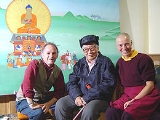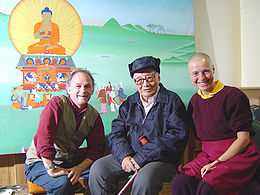
Sherab Palden Beru
Encyclopedia
Sherab Palden Beru is a celebrated exiled Tibetan thangka
artist who has played a key role in preserving the art-form through the training of western students over a period of more than four decades.
at the age of nine. His aptitude for drawing was quickly recognised, and his formal artistic training began from the age of 13, under the guidance of the monastery's artist-lama
. Nine years later, he completed his first thangka.
It was whilst studying at Namgyal Ling that Sherab attained high levels of skill, not only in Thangka painting, but also in associated monastic disciplines such as ritual music, and Lama dancing in particular. In 1956, after over 30 years of living at the monastery, Beru left for Lhasa
, where he stayed for three years, until forced to escape to India
following the invasion of Tibet by Chinese forces.
Once in India, Sherab Palden began thangka painting again, based for a while in Dalhousie
where, amongst other works, he was commissioned by Lokesh Chandra
to produce a series of drawings of mandala
s for publication. He was then asked by the 16th Karmapa, Rangjung Rigpe Dorje, to make his way to Scotland
where Chogyam Trungpa
and Akong Tulku Rinpoche
had established the first Tibetan Buddhist centre in the west, Kagyu Samye Ling, in Eskdalemuir
, Dumfriesshire
. Despite having some initial misgivings about leaving the Tibetan community in exile in Northern India so soon after having arrived as a refugee, Sherab Palden acceded to the wishes of his Guru.
For the next 35 years, Sherab Palden devoted himself to creating thangkas of outstanding quality in the Karma Gadri style, and to training western students in the techniques of thangka painting. His work can be seen in centres through Europe, Asia and North America.
His principal achievements are to be seen at Samye Ling itself, where he designed not only the temple interior but several cycles of exquisite thangkas, depicting variously the Kagyu
Lineage holders, Sakyamuni Buddha, Indian mahasiddhas and the Four Directional Guardians. Most notable are the much-copied painting of the Kagyu Lineage Refuge Tree and the painting of the Guru Yoga of the 8th Karmapa, Mikyo Dorje. He painted the thangka of Vajradhara in the Dorje Dzong shrine room in Boulder, Colorado.
The paintings in the temple at Samye Ling are remarkable for their combination of large size and exquisite detail. As in Tibet, many of these paintings took between one and three years to complete. Along with Akong Rinpoche and his students, Sherab Palden also helped retrieve, restore and preserve thangkas from Tibet, many of which were destroyed in the early days of the Chinese occupation. Later Sherab Palden was joined at Samye Ling by his nephew, Gyamtso Tashi, an ordained monk and sculptor, who reached India after making a three-year pilgrimage on foot across Tibet.
Now well into his 90s, Sherab Palden no longer contributes directly to the art-work, but remains a leading authority on matters of Tibetan art, and is regularly consulted by practicing thangka artists.
Thangka
A "Thangka," also known as "Tangka", "Thanka" or "Tanka" is a Tibetan silk painting with embroidery, usually depicting a Buddhist deity, famous scene, or mandala of some sort. The thankga is not a flat creation like an oil painting or acrylic painting...
artist who has played a key role in preserving the art-form through the training of western students over a period of more than four decades.

Life and work
Born into a nomadic family that had lived in the eastern province of Kham since the mid-15th century, Beru entered the Namgyal Ling monasteryMonastery
Monastery denotes the building, or complex of buildings, that houses a room reserved for prayer as well as the domestic quarters and workplace of monastics, whether monks or nuns, and whether living in community or alone .Monasteries may vary greatly in size – a small dwelling accommodating only...
at the age of nine. His aptitude for drawing was quickly recognised, and his formal artistic training began from the age of 13, under the guidance of the monastery's artist-lama
Lama
Lama is a title for a Tibetan teacher of the Dharma. The name is similar to the Sanskrit term guru .Historically, the term was used for venerated spiritual masters or heads of monasteries...
. Nine years later, he completed his first thangka.
It was whilst studying at Namgyal Ling that Sherab attained high levels of skill, not only in Thangka painting, but also in associated monastic disciplines such as ritual music, and Lama dancing in particular. In 1956, after over 30 years of living at the monastery, Beru left for Lhasa
Lhasa
Lhasa is the administrative capital of the Tibet Autonomous Region in the People's Republic of China and the second most populous city on the Tibetan Plateau, after Xining. At an altitude of , Lhasa is one of the highest cities in the world...
, where he stayed for three years, until forced to escape to India
India
India , officially the Republic of India , is a country in South Asia. It is the seventh-largest country by geographical area, the second-most populous country with over 1.2 billion people, and the most populous democracy in the world...
following the invasion of Tibet by Chinese forces.
Once in India, Sherab Palden began thangka painting again, based for a while in Dalhousie
Dalhousie, India
Dalhousie is a hill station and popular tourist spot in the northern state of Himachal Pradesh, India.- Weather :Dalhousie experiences winter-like cold climate throughout the year. Heavy rain with thunder showers are experienced during the period from June to September...
where, amongst other works, he was commissioned by Lokesh Chandra
Lokesh Chandra
Lokesh Chandra is a contemporary scholar of Buddhism and the Indian arts. He is the son of the famous Sanskrit scholar Raghu Vira. He has also served as a member of the Indian Rajya Sabha, Vice-President of the Indian Council for Cultural Relations, and Chairman of the Indian Council of Historical...
to produce a series of drawings of mandala
Mandala
Maṇḍala is a Sanskrit word that means "circle". In the Buddhist and Hindu religious traditions their sacred art often takes a mandala form. The basic form of most Hindu and Buddhist mandalas is a square with four gates containing a circle with a center point...
s for publication. He was then asked by the 16th Karmapa, Rangjung Rigpe Dorje, to make his way to Scotland
Scotland
Scotland is a country that is part of the United Kingdom. Occupying the northern third of the island of Great Britain, it shares a border with England to the south and is bounded by the North Sea to the east, the Atlantic Ocean to the north and west, and the North Channel and Irish Sea to the...
where Chogyam Trungpa
Chögyam Trungpa
Chögyam Trungpa Rinpoche was a Buddhist meditation master and holder of both the Kagyu and Nyingma lineages, the eleventh Trungpa tülku, a tertön, supreme abbot of the Surmang monasteries, scholar, teacher, poet, artist, and originator of a radical re-presentation of Shambhala vision.Recognized...
and Akong Tulku Rinpoche
Akong Rinpoche
Chöje Akong Rinpoche is a tulku in the Kagyu school of Tibetan Buddhism and a founder of the Samye Ling Monastery. He was born in 1939, near Riwoq in Kham, Eastern Tibet. At the age of two he was discovered by the search party seeking the reincarnation of the previous Akong, Abbot of Dolma...
had established the first Tibetan Buddhist centre in the west, Kagyu Samye Ling, in Eskdalemuir
Eskdalemuir
-External links:*...
, Dumfriesshire
Dumfriesshire
Dumfriesshire or the County of Dumfries is a registration county of Scotland. The lieutenancy area of Dumfries has similar boundaries.Until 1975 it was a county. Its county town was Dumfries...
. Despite having some initial misgivings about leaving the Tibetan community in exile in Northern India so soon after having arrived as a refugee, Sherab Palden acceded to the wishes of his Guru.
For the next 35 years, Sherab Palden devoted himself to creating thangkas of outstanding quality in the Karma Gadri style, and to training western students in the techniques of thangka painting. His work can be seen in centres through Europe, Asia and North America.
His principal achievements are to be seen at Samye Ling itself, where he designed not only the temple interior but several cycles of exquisite thangkas, depicting variously the Kagyu
Kagyu
The Kagyu, Kagyupa, or Kagyud school, also known as the "Oral Lineage" or Whispered Transmission school, is today regarded as one of six main schools of Himalayan or Tibetan Buddhism, the other five being the Nyingma, Sakya, Jonang, Bon and Gelug...
Lineage holders, Sakyamuni Buddha, Indian mahasiddhas and the Four Directional Guardians. Most notable are the much-copied painting of the Kagyu Lineage Refuge Tree and the painting of the Guru Yoga of the 8th Karmapa, Mikyo Dorje. He painted the thangka of Vajradhara in the Dorje Dzong shrine room in Boulder, Colorado.
The paintings in the temple at Samye Ling are remarkable for their combination of large size and exquisite detail. As in Tibet, many of these paintings took between one and three years to complete. Along with Akong Rinpoche and his students, Sherab Palden also helped retrieve, restore and preserve thangkas from Tibet, many of which were destroyed in the early days of the Chinese occupation. Later Sherab Palden was joined at Samye Ling by his nephew, Gyamtso Tashi, an ordained monk and sculptor, who reached India after making a three-year pilgrimage on foot across Tibet.
Now well into his 90s, Sherab Palden no longer contributes directly to the art-work, but remains a leading authority on matters of Tibetan art, and is regularly consulted by practicing thangka artists.

